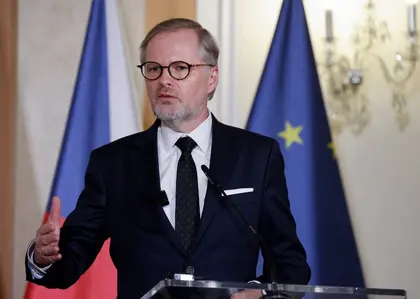A Kyiv official has said Moscow may as well employ “a shaman with tambourines” to protect its bomber aircraft, after it emerged the Kremlin’s air forces have been painting planes on the ground in an attempt to fool Ukrainian strike planners.
First reported by The Drive earlier this week, new satellite images show silhouettes of Tu-95MS “Bear-H” strategic bombers on the tarmac of Russia’s Engels Air Base.
JOIN US ON TELEGRAM
Follow our coverage of the war on the @Kyivpost_official.
During an interview with Channel 24, Andriy Yusov, a representative of the Main Directorate of Intelligence of the Ministry of Defense (HUR), said: “Satellites captured the process of their painting, but they (Russians) seem to believe they can deceive someone with this.”
Mocking the endeavor, Yusov suggested that the Russians could enlist the services of "a shaman with tambourines," something he claimed is “a very popular phenomenon” among “the political elite of Russia.”
Ukraine has had a number of recent successes in recent weeks targeting Russian airfields with drones and in response, Russia has resorted to increasingly desperate countermeasures.
Such efforts include parking expensive anti-aircraft missile systems on towers, piling used truck tires on the wings of strategic bombers, and putting up smoke screens.
Kyiv’s drone campaign, aside from strikes around Moscow, appears to be prioritizing Russian air force jets and airbases, particularly those used for the Kremlin’s long-running cruise and kamikaze drone bombardment of Ukraine launched in October 2022.

FSB Officer Shot Dead in Moscow Ministry of Defense Building
The Ukrainian drone raids since Aug. 22 have scored some spectacular successes against the supposedly heavily defended air bases, damaging at least three Tu-22 strategic bombers parked in airfields near Novgorod and St. Petersburg, and an undetermined number of fighter jets in a strike near Bryansk. On Aug. 30 a drone swarm hit a military airfield near Pskov, according to reports, destroying two Il-76 transport jets totally and damaging two more beyond repair.
"That's why we see car tires and airplane graffiti – it's an effort to deceive modern technology and satellites using obsolete methods," Yusov said.
According to Yusov, the purpose of the painted planes was to create false targets that would be challenging to distinguish on low-resolution satellite imagery. However, for this deception to work, the satellite must capture the image from a precise angle.
On satellite images with higher resolution, such patterns could be quickly identified due to the absence of details and shadows.
You can also highlight the text and press Ctrl + Enter






